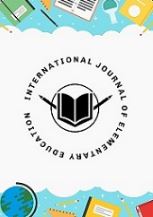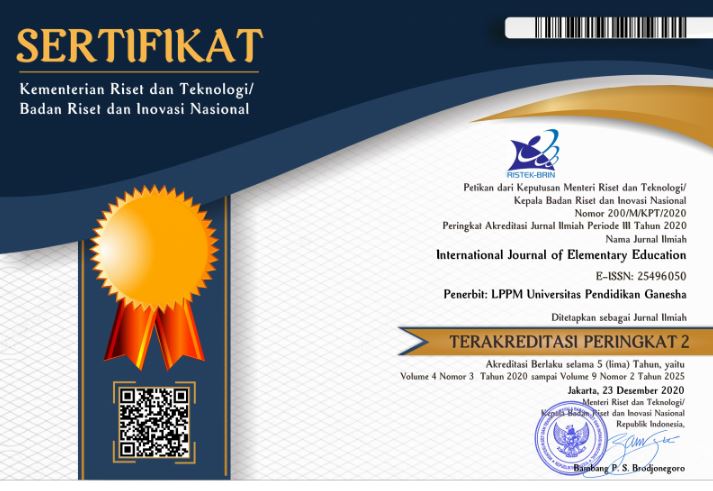Comic Media to Improve Speaking Skill of the Fourth Grade Students
DOI:
https://doi.org/10.23887/ijee.v6i4.55510Keywords:
Development, comic media, speaking skillsAbstract
Comic media can improve students' speaking skills. The use of comic media that is suitable for child development can improve the learning quality and make it easier for learning objectives to be achieved quickly. In addition, students also gain experience in language, namely the addition of new vocabulary and improve speaking skills. The purpose of this research is to improve the speaking skills of the fourth grade elementary school students by using comic media that have met the eligibility criteria. This research is a development research with ADDIE method which includes five stages; Analysis, Design, Development, Implementation, and Evaluation. This study involving 3 validators, consist of a media expert, material expert, and language expert and in trial was carried out on 10 students. The process of data analysis including validity test, reliability test, normality test, and pair T-Test. Based on the results of the reliability test, before and after the obtained value of cronbanch's alpha is greater than the total correlated item and is declared reliable. information was obtained that the value of Sig. There is an increase in the average score after using comic media, meaning that there is an influence in the provision of comic media on students' speaking skills. It was concluded that comic media can improve students' speaking skills.
References
Alit, K., Adnyani, D., Wibawa, I. M. C., & Margunayasa, I. G. (2021). Alternative Energy Sources on Digital Comic Media. International Journal of Elementary Education, 5(1), 61–70. https://doi.org/10.23887/ijee.v5i1.34333.
Alviolita, N. W., & Huda, M. (2019). Media Pop Up Book dalam Pembelajaran Bercerita. Jurnal Pendidikan Bahasa Indonesia, 7(1), 49–57. https://doi.org/10.30659/j.7.1.49-57.
Amaniarsih, D. S., Juliana, J., & Darmayanti, E. (2022). Improving Students’speaking Skill At Grade X At Sma Nurul Hasanah Tembung Through Community Language Learning Method. Warta Dharmawangsa, 16(3), 299–312. https://doi.org/10.46576/wdw.v16i3.2225.
Anggito, A., & Sartono, E. K. E. (2022). The development of multicultural education comics to embed tolerance character for 4th grade of elementary school. Jurnal Prima Edukasia, 10(1), 66–81. https://doi.org/10.21831/jpe.v10i1.40504.
Apriati, L., Mulawarman, W. G., & Ilyas, M. (2021). Pengembangan Bahan Ajar Menyimak Berbasis Multimedia Interaktif pada Pelajaran Tematik dengan Tema “Indahnya Kebersamaan” untuk Siswa Kelas IV Sekolah Dasar. Diglosia: Jurnal Kajian Bahasa, Sastra, Dan Pengajarannya, 4(1), 13–22. https://doi.org/10.30872/diglosia.v4i1.73.
Delfakhria, D., & Solfema, S. (2022). Development of Integrated Thematic Teaching Materials with Mind Mapping Model in Class III of Elementary School. AL-ISHLAH: Jurnal Pendidikan, 14(2), 2313–2326. https://doi.org/10.35445/alishlah.v14i2.1282.
Farhrohman, O. (2017). Implementasi Pembelajaran Bahasa Indonesia di SD/MI. Primary: Jurnal Keilmuan Dan Kependidikan Dasar, 9(1), 23–34. http://www.jurnal.uinbanten.ac.id/index.php/primary/article/view/412.
Febriansyah, D., Dwiputra, K., Budiyanto, T. M., & Adz, T. (2020). Textbooks Transformation Into Digital Comics As Innovative Learning Media for Social Science Studies in Junior High School. International Journal Pedagogy of Social Studies, 5(2), 9–16. https://doi.org/10.17509/ijposs.v5i2.29068.
Fitriyani, Y., Supriatna, N., & Sari, M. Z. (2021). Pengembangan Kreativitas Guru dalam Pembelajaran Kreatif pada Mata Pelajaran IPS di Sekolah Dasar. Jurnal Kependidikan: Jurnal Hasil Penelitian Dan Kajian Kepustakaan Di Bidang Pendidikan, Pengajaran Dan Pembelajaran, 7(1), 97. https://doi.org/10.33394/jk.v7i1.3462.
Gumilang, M. R., Wahyudi, W., & Indarini, E. (2019). Pengembangan Media Komik dengan Model Problem Posing untuk Meningkatkan Kemampuan Pemecahan Masalah Matematika. Journal of Medives : Journal of Mathematics Education IKIP Veteran Semarang, 3(2), 185. https://doi.org/10.31331/medivesveteran.v3i2.860.
Hardiyanti, W. E., Ilham, M., Ekadayanti, W., & Jafarudin, J. (2020). Pelatihan Pembuatan Video Animasi Gambar “Powtoon” bagi Guru PAUD. Abdimas Pedagogi: Jurnal Ilmiah Pengabdian Kepada Masyarakat, 3(2), 78. https://doi.org/10.17977/um050v3i2p78-86.
Hermawan, D. (2018). Kesantunan Berbahasa Pada Anak Usia 11 Tahun (Studi Kasus terhadap Anak Usia 11 Tahun). Jurnal Bahasa, Sastra Indonesia Dan Pengajarannya, 11(1), 1–9. https://unibba.ac.id/ejournal/index.php/metamorfosis/article/view/23.
İlhan, G. O., Kaba, G., & Sin, M. (2021). Usage of Digital Comics in Distance Learning During COVID-19. International Journal on Social and Education Sciences, 3(1), 161–179. https://doi.org/10.46328/ijonses.106.
Kafi, F. A., & Husna, Z. F. (2022). Innovation of Arabic Speaking Skill Development with Comic Media at MTs Mabdaul Ma’arif Jember. Al-Fusha: Arabic Language Education Journal, 4(2), 45–51. https://doi.org/10.36835/alfusha.v4i2.853.
Karo-Karo, I. R., & Rohani, R. (2018). Manfaat Media dalam Pembelajaran. AXIOM : Jurnal Pendidikan Dan Matematika, 7(1), 91–96. https://doi.org/10.30821/axiom.v7i1.1778.
Lusiyani, R., & Dara Anindya, W. (2021). Choosing and Using Learning Media during Remote Teaching: Teachers’ Thought. Journal of English Language Teaching and Linguistics) e-ISSN, 6(2), 2021. https://doi.org/10.21462/jeltl.v6i2.555.
Mahayanti, N. W. S., Artini, L. P., & Jannah, N. (2017). the Effect of Big Book As Media on Students’ Reading Comprehension At Fifth Grade of Elementary School in Sd Laboratorium Undiksha Singaraja. International Journal of Language and Literature, 1(3), 2549–4287. https://doi.org/10.23887/ijll.v1i3.12544.
Mahendra, E. R., Siantoro, G., & Pramono, M. (2021). Pengembangan Komik Pendidikan Sebagai Media Pembelajaran Dan Pengaruhnya Terhadap Motivasi Belajar Siswa. Jurnal Education and Development, 9(1), 279–284. http://journal.ipts.ac.id/index.php/ED/article/view/2375.
Nugroho, I. A., & Surjono, H. D. (2019). Pengembangan multimedia pembelajaran interaktif berbasis video materi sikap cinta tanah air dan peduli lingkungan. Jurnal Inovasi Teknologi Pendidikan. https://doi.org/10.21831/jitp.v6i1.15911.
Okal, B. O. (2014). Benefits of Multilingualism in Education. Universal Journal of Educational Research, 2(3), 223–229. https://doi.org/10.13189/ujer.2014.020304.
Oradee, T. (2013). Developing Speaking Skills Using Three Communicative Activities (Discussion, Problem-Solving, andRole-Playing). International Journal of Social Science and Humanity, 2(6), 533–535. https://doi.org/10.7763/ijssh.2012.v2.164.
Palupi, R. E. A. (2021). Students’ Speaking Anxiety: Ready or Not. ELE Reviews: English Language Education Reviews, 1(1), 61–71. https://doi.org/10.22515/ele-reviews.v1i1.3592.
Praheto, B. E., Andayani, Rohmadi, M., & Wardani, N. E. (2020). The effectiveness of interactive multimedia in learning Indonesian language skills in higher education. Rupkatha Journal on Interdisciplinary Studies in Humanities. https://doi.org/10.21659/rupkatha.v12n1.34.
Ramdani, A. S. (2019). The Use of Voki as A Media to Support the Enhancement of First Grade Students Speaking Skills at SMPN 4 Tambun Selatan. Jurnal Inovasi Pendidikan MH Thamrin, 2(1), 12–25. https://doi.org/10.37012/jipmht.v2i1.32.
Rina, N., Suminar, J. R., Damayani, N. A., & Hafiar, H. (2020). Character education based on digital comic media. International Journal of Interactive Mobile Technologies, 14(3), 107–127. https://doi.org/10.3991/ijim.v14i03.12111.
Rosyida, A., Mustaji, M., & Subroto, W. (2018). The Development of Contextual Teaching and Learn-ing-Based Comic as a Learning Media for Elementary School Students. 173(Icei 2017), 13–16. https://doi.org/10.2991/icei-17.2018.4.
Sadiku, L. M. (2015). The Importance of Four Skills Reading, Speaking, Writing, Listening in a Lesson Hour. European Journal of Language and Literature, 1(1), 29. https://doi.org/10.26417/ejls.v1i1.p29-31.
Sahan, P., Muin, A., & Jauhar, S. (2021). Hubungan antara Kebiasaan Membaca Dengan Hasil Belajar Bahasa Indonesia Siswa di SD Inpres 12/79 Macanang. JPPSD: Jurnal Pendidikan Dan Pembelajaran Sekolah Dasar, 1(1), 35. https://doi.org/10.26858/pjppsd.v1i1.22954.
Santika, D. A., Mulyana, E. H., & Nur, L. (2020). Pengembangan Media Pembelajaran Model STEM pada Konsep Terapung Melayang Tenggelam untuk Memfasilitasi Keterampilan Saintifik Anak Usia Dini. Jurnal Paud Agapedia, 4(1), 171–184. https://doi.org/10.17509/jpa.v4i1.27207.
Saputri, D. Y., Rukayah, R. R., & Indriayu, M. I. (2018). Integrating Game-based Interactive Media as Instructional Media: Students’ Response. Journal of Education and Learning (EduLearn), 12(4), 638–643. https://doi.org/10.11591/edulearn.v12i4.8290.
Sembiring, E. B., Wahyuni, D., & Anurogo, W. (2018). Multimedia Interaktif Pengenalan Hewan Dan Tumbuhan Langka Menggunakan Model Tutorial. Journal of Digital Education, Communication, and Arts (Deca), 1(2), 103–112. https://doi.org/10.30871/deca.v1i2.839.
Sembiring, S. B., Agung, A. A. G., & Antara, P. A. (2021). Media Audio Visual dengan Tema Lingkunganku Terhadap Keterampilan Berbicara Anak di Depan Umum. Jurnal Pendidikan Anak Usia Dini Undiksha, 9(3), 371. https://doi.org/10.23887/paud.v9i3.40134.
Setyawan, A., Novitri, Q. A., Rahartini, S., Pratiwi, E., Walidain, M. B., Guru, P., Dasar, S., Madura, U. T., & Indonesia, J. T. (2020). Kesulitan Belajar Siswa di Sekolah Dasar (SD). Prosiding Nasional Pendidikan : LPPM IKIP PGRI Bojonegoro, 1(1), 156–158. http://jurnal.untag-sby.ac.id/index.php/persona/article/download/2802/2902.
Surya, A., Poerwanti, J. I. S., & Sriyanto, M. I. (2020). The Effectiveness of the Use of Digital-Based Educational Comic Media in Improving Reading Interest in Elementary School Students. 397(Icliqe 2019), 411–415. https://doi.org/10.2991/assehr.k.200129.052.
Suryansah, T., & Suwarjo, S. (2016). Pengembangan Video Pembelajaran Untuk Meningkatkan Motivasi Dan Hasil Belajar Kognitif Siswa Kelas Iv Sd. Jurnal Prima Edukasia, 4(2), 209. https://doi.org/10.21831/jpe.v4i2.8393.
Taka, S. D. (2019). Teaching Speaking by Using Snake and Ladder Board Game. IDEAS: Journal on English Language Teaching and Learning, Linguistics and Literature, 7(2), 72–86. https://doi.org/10.24256/ideas.v7i2.1021.
Tambunan, L. R., & Sundari, E. (2020). Pengembangan Buku Digital Pada Materi Persamaan Garis Singgung Lingkaran. AKSIOMA: Jurnal Program Studi Pendidikan Matematika, 9(4), 1184. https://doi.org/10.24127/ajpm.v9i4.3084.
Tiarasari, A. T., Sukarno, S., & Sarwanto, S. (2018). Interactive Multimedia Use To Increase Learning Interest. Social, Humanities, and Educational Studies (SHEs): Conference Series, 1(1), 38–47. https://doi.org/10.20961/shes.v1i1.23540.
Toh, T. L., Cheng, L. P., Ho, S. Y., Jiang, H., & Lim, K. M. (2017). Use of comics to enhance students’ learning for the development of the twenty-first century competencies in the mathematics classroom. Asia Pacific Journal of Education, 37(4), 437–452. https://doi.org/10.1080/02188791.2017.1339344.
Winarni, E. W., Hambali, D., & Purwandari, E. P. (2020). Analysis of language and scientific literacy skills for 4th grade elementary school students through discovery learning and ict media. International Journal of Instruction, 13(2). https://doi.org/10.29333/iji.2020.13215a.
Yamin, M. R., & Karmila. (2020). Analisis Kebutuhan Pengembangan Media Pembelajaran Berbasis Cartoon dalam Pembelajaran IPA pada Materi Lingkungan Kelas III SD. Biology Teaching and Learning, 2(2), 159–170. https://doi.org/10.35580/btl.v2i2.12307.
Yuniarti, A., & Radia, E. H. (2021). Development of Comic Mathematics Teaching Materials on Flat-Building Material to Increase Reading Interest in Class IV Elementary School Students. Journal of Education Technology, 4(4), 415. https://doi.org/10.23887/jet.v4i4.30034.
Downloads
Published
How to Cite
Issue
Section
License
Copyright (c) 2022 Nella Dwi Andini, Otang Kurniaman, Syahrilfuddin

This work is licensed under a Creative Commons Attribution-ShareAlike 4.0 International License.
Authors who publish with the International Journal of Elementary Education agree to the following terms:
- Authors retain copyright and grant the journal the right of first publication with the work simultaneously licensed under a Creative Commons Attribution License (CC BY-SA 4.0) that allows others to share the work with an acknowledgment of the work's authorship and initial publication in this journal.
- Authors are able to enter into separate, additional contractual arrangements for the non-exclusive distribution of the journal's published version of the work (e.g., post it to an institutional repository or publish it in a book), with an acknowledgment of its initial publication in this journal.
- Authors are permitted and encouraged to post their work online (e.g., in institutional repositories or on their website) prior to and during the submission process, as it can lead to productive exchanges, as well as earlier and greater citation of published work. (See The Effect of Open Access)









